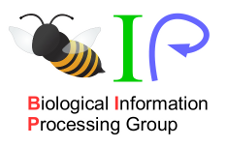Project: E. Coli Chemotaxis and Memory Quantification
In order to survive, the E. coli cell performs chemotaxis towards nutrients. By employing a complex adapation process, the cell is able to effectively navigate in a vast amount of ligand concentrations magnitudes. Nutrient sensing chemoreceptors adapt to the environment by methylation and de-methylation. This process is the cells way of storing information about the past environment.
In our research, we stochastically simulate the signaling pathway from sensing chemoreceptors to the protein CheY-P and finally to the cell’s flagellar motors, which play a critical role in navigation. We employ a modified version of Gillespie’s algorithm in order to secure a correct stochastical simulation of chemical reactions between proteins.
By evaluating the current methylation state of all receptors and comparing it to the cell’s past, we are able to quantify how well E. coli is able to store information. One current research interest are ways of scaling this memory and the relationship between memory and chemotactic performance. Another interesting topic is the relation between the adaptation and movement timescale in varying environments, which we are able to scale as well.
Publication:
Shape, geometric percolation, and electrical conductivity of clusters in suspensions of hard platelets.
Arshia Atashpendar, Tim Ingenbrand, and Tanja Schilling.
Phys. Rev. E 101, 032706 – Published 31 March 2020
Education:
Bachelor of Science in Physics in Freiburg (2016-2019)
Master of Science in Physics in Freiburg and Heidelberg (2019- )
Contact:
tim.ingenbrand@bioquant.uni-heidelberg.de

